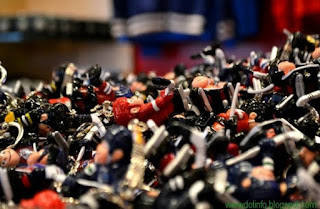Agen Domino is a game played with rectangular "domino" tiles. The domino gaming pieces make up a domino set, sometimes called a deck or pack. The traditional Sino-European domino set consists of 28 dominoes, colloquially nicknamed bones, cards, tiles, tickets, stones, or spinners. Each domino is a rectangular tile with a line dividing its face into two square ends. Each end is marked with a number of spots (also called pips, nips, or dobs) or is blank. The backs of the dominoes in a set are indistinguishable, either blank or having some common design. A agen domino set is a generic gaming device, similar to playing cards or dice, in that a variety of games can be played with a set.
The earliest mention of dominoes is from Song dynasty China, found in the text Former Events in Wulin. Agen Domino QQ first appeared in Italy during the 18th century, and although it is unknown how Chinese dominoes developed into the modern game, it is speculated that Italian missionaries in China may have brought the game to Europe.
The name "domino 99" is from the resemblance to a kind of hood worn during the Venice carnival.
Construction and composition of domino setsEuropean-style dominoes are traditionally made of bone such as ivory, or a dark hardwood such as ebony, with contrasting black or white pips (inlaid or painted). Alternatively, domino sets have been made from many different natural materials: stone (e.g., marble, granite or soapstone); other hardwoods (e.g., ash, oak, redwood and cedar); metals (e.g., brass or pewter); ceramic clay, or even frosted glass or crystal. These sets have a more novel look, and the often heavier weight makes them feel more substantial, but such materials and the resulting products are usually much more expensive than polymer materials.
Modern commercial domino sets are usually made of synthetic materials, such as ABS or polystyrene plastics, or Bakelite and other phenolic resins; many sets approximate the look and feel of ivory while others use colored or even translucent plastics to achieve a more contemporary look. Modern sets also commonly use a different color for the dots of each different end value (one-spots might have black pips while two-spots might be green, three red, etc.) to facilitate finding matching ends. Occasionally, one may find a domino set made of card stock like that for playing cards. Such sets are lightweight, compact and inexpensive, but like cards are more susceptible to minor disturbances such as a sudden breeze. Sometimes dominoes have a metal pin (called a spinner or pivot) in the middle.
The traditional set of dominoes contains one unique piece for each possible combination of two ends with zero to six spots, and is known as a double-six set because the highest-value piece has six pips on each end (the "double six"). The spots from one to six are generally arranged as they are on six-sided dice, but because there are also blank ends having no spots there are seven possible faces, allowing 28 unique pieces in a double-six set.
However, this is a relatively small number especially when playing with more than four people, so many domino sets are "extended" by introducing ends with greater numbers of spots, which increases the number of unique combinations of ends and thus of pieces. Each progressively larger set increases the maximum number of pips on an end by three, so the common extended sets are double-nine, double-twelve, double-fifteen and double-eighteen. Larger sets such as double-twenty-one can theoretically exist but are rarely seen in retail stores, as identifying the number of pips on each domino becomes difficult, and a double-twenty-one set would have 253 pieces, far more than is normally necessary for most domino games even with eight players.
Source : articlesbase.com

0 comments:
Post a Comment